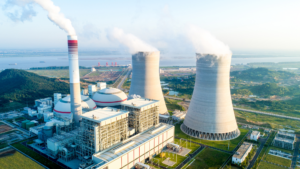
Protons and neutrons form the nucleus of the atom, with electrons orbiting around them. In most instances, the magnetic charge between the protons and electrons holds them in place. However, in some molecules, the outermost electrons are so weakly attracted that a strong magnetic field can pull them out of orbit and shift them to other atoms. These detached electrons are electricity.
How Electricity is Generated
Though electricity is the primary way we power our homes, it’s actually a secondary power source made by converting other energy sources (coal, natural gas, uranium, etc.). In the majority of power plants, this is done by burning fossil fuels. The heat boils water, which generates steam. The steam is then funneled into a turbine, where it turns a number of propeller-like blades attached to a central shaft.
As the shaft turns, it spins a magnet wrapped in copper wires inside a generator connected to the turbine. Moving copper through a magnetic field creates different voltages at either end of the wire, strong enough to pull electrons from their orbits, thereby creating a steady and powerful flow of electricity that’s carried to your home.
While any metal conductor will produce electricity inside a generator, copper is the most widely used because it produces the most electrons for the lowest cost. Silver is more conductive, but more costly. Aluminum is cheaper, but less conductive.
Common Electrical Energy Sources
Ultimately, all electrical power comes from either the sun or the earth. When we flip a light switch, we’re harnessing nature to light our homes. The most common energy sources in the United States are:
- Fossil Fuels. Burning coal and natural gas generates around sixty percent of the electricity we consume. A small amount of petroleum is used to generate electricity as well, though it accounts for less than one percent of total electricity consumption.
- Uranium. Nuclear power generates almost 20 percent of America’s electricity. In a nuclear reactor, uranium fuel is lowered into tanks of heavy water, where its atoms gradually split apart, creating steam used to power turbines. A single uranium pellet contains as much energy as a ton of coal.
- Water. Hydroelectric dams feed water through turbines to produce electricity. Though running water is created by gravity, hydropower is actually a product of the sun. Solar energy evaporates water, which condenses into rain that feeds our lakes and rivers. Approximately seven percent of our power is hydroelectric.
- Wind. The largest source of renewable energy in the United States, wind is responsible for around nine percent of our electricity. Like water, wind is created by solar energy. When the sun heats the Earth, it creates pockets of warm and cold air. As warm air rises, cold air moves in to take its place, creating the wind we use to power turbines.
- Sunlight. Around three percent of the energy we consume comes directly from the sun. Solar panels absorb sunlight, which heats photovoltaic cells until their electrons are pushed out of orbit. Other solar plants reflect sunlight instead, using it to boil water and spin turbines.
Biomass and geothermal energy account for the remainder of our electricity. Each generates heat that powers turbines, similar to fossil fuels.
Protecting Your Electrical System
Agway doesn’t just power your home; we protect it. Our EnergyGuardTM Program covers your heating, cooling, and electrical systems* against damage caused by wear and tear. Home insurance doesn’t cover worn parts, but EnergyGuardTM does.
Our support team is standing by 24/7, ready to help when the need for repair occurs. Rather than waste time searching for a qualified repairman, our extensive network of local contractors sends a technician to your door as soon as possible. What’s more, we pay for all corrective maintenance and covered parts. There are no service fees or deductibles either. Everything is included in your supply costs. Sign up today to start saving on repairs!
*Coverage depends on commodity purchased.